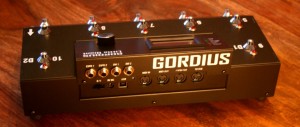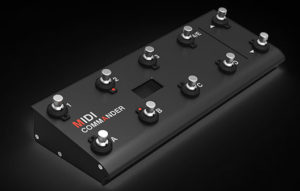This is the hardware page. here you can find general directions about the right Control method.
Looping tools that sit on a table or are in a computer usually are operated by external controllers, often a pedal to keep the hands free. Some tools have MIDI or 1/4″ inputs to allow calling functions that are not or not easily accessible on their own interface. You could consider also using a drum pad controller (like Trigger Finger, QuNeo) or a keyboard – great for accuracy and versatility! Touch screens can be even more versatile and silent, although more delicate and dirt sensitive…
Probably the most popular pedal to control a looper that receives MIDI is the Behringer FCB-1010. It is robust and cheap and once programmed, it works for a long time. However, it is bulky and there have been no updates in years.
More sophisticated and more creative (in the sense that we can talk to the person that creates them) is the Gordius Little Giant. This was developed by the same team that created the Uno chip which expands the features of the FCB1010.
Here’s a new midi foot pedal from MeloAudio. Compact, solidly built, with 10 banks of 8 commands midi out and sockets for 2 expression pedals. There doesn’t seem to be a software editor.
The Nektar Pacer is a new product that looks very powerful. It now has editor software here.
Very interesting for its size and features is the Keith McMillen SoftStep and 12 Step.
The creator of those pedals is a livelooper himself and contributed a lot to spread the idea! Here, another looping friend created a work around the big Max app that controls the SoftStep
there are more suitable pedals and loads of hand controllers. please contribute your experiences!
Be careful not to buy a pedal that only sends Program Change! those do not send a button release signal and thus are very limited!
Kim Flint wrote a Footpedal Tutorial for the Echoplex which contains interesting information valid for other units, too.
here is a list of controllers from 2017






